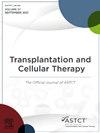先天性免疫缺陷儿童异体造血细胞移植后胸腺移植物的相关性
IF 3.6
3区 医学
Q2 HEMATOLOGY
引用次数: 0
摘要
背景:同种异体造血细胞移植(HCT)可以治愈许多先天性免疫缺陷(IEI)。及时的新胸腺发育对HCT术后良好的临床结果至关重要。通过流式细胞术测量循环新近胸腺移植物(RTE;CD31+CD4+CD45RA+ T细胞)。目的:我们假设RTE的降低与HCT时年龄较大的基线HCT特征和暴露于更大的HCT调节强度有关,以及HCT结果包括混合(研究设计:在本回顾性分析中,在两个中心确定了两组儿童IEI HCT接受者,收集了异体HCT后的RTE数据。在这两个队列中,记录了患者和HCT信息,包括但不限于患者年龄、淋巴供体嵌合和急性GvHD的发生情况。用这些协变量和时间对RTE的重复测量拟合混合效应模型。结果:在2012年至2021年期间,两个队列中共有162名儿童IEI HCT移植受者符合纳入条件。队列A (n=34)包括23名男性(68%)。HCT的中位年龄为2.2岁(四分位数间距(IQR) 0.8至10.8)。8只(23.5%)进行了强度降低(RIC), 23只(67.7%)进行了毒性降低(RTC), 3只(8.8%)进行了清髓(MAC)调节。所有患者均接受阿仑单抗血清治疗。队列B (n=128)包括87名男性(68%)。HCT的中位年龄为1.4岁(IQR为0.7 - 5.3)。76例(59.4%)接受RIC, 38例(29.7%)接受RTC, 14例(10.9%)接受MAC。RIC和RTC患者接受阿仑单抗血清治疗,MAC抗胸腺细胞球蛋白。在队列A的HCT后1年RTE的线性混合效应模型中,显著的负相关包括年龄增加(结论:RTE的连续测量是HCT后胸腺功能的有用评估。在IEI患儿中,移植年龄较大、适应强度较大和2-4级急性GvHD的发生与胸腺源性免疫重建较慢密切相关。在线性混合效应模型中,混合淋巴供体嵌合与RTE无关。除了增强目前对HCT结果的预期指导外,这些发现还可以指导方案的个性化,以优化IEI HCT的临床结果。本文章由计算机程序翻译,如有差异,请以英文原文为准。
Relevance of Recent Thymic Emigrants Following Allogeneic Hematopoietic Cell Transplantation for Pediatric Patients with Inborn Errors of Immunity
Background
Allogeneic hematopoietic cell transplantation (HCT) can be curative for many inborn errors of immunity (IEI). Timely neothymopoiesis is paramount to favorable clinical outcomes after HCT. Neothymopoiesis can be quantified by flow cytometric measurement of circulating recent thymic emigrants (RTE; CD31+CD4+CD45RA+ T cells).
Objectives
We hypothesized that decreased RTE would be associated with baseline HCT characteristics of older age at time of HCT and exposure to greater HCT conditioning intensity, as well as with HCT outcomes including mixed (<95%) lymphoid donor chimerism and presence of acute graft-versus-host disease (GvHD).
Study Design
In this retrospective analysis two cohorts of pediatric IEI HCT recipients were identified at two centers that collected RTE data following allogeneic HCT. For both cohorts, patient and HCT information was recorded including but not limited to patient age, lymphoid donor chimerism, and occurrence of acute GvHD. Mixed effects models were fitted for the repeated measures of RTE with these covariates and time.
Results
Between 2012 and 2021, a total of 162 pediatric IEI HCT recipients transplanted across both cohorts were eligible for inclusion. Cohort A (n = 34) included 23 males (68%). Median age at HCT was 2.2 years (interquartile range (IQR) 0.8 to 10.8). Eight (23.5%) underwent reduced intensity (RIC), 23 (67.7%) reduced toxicity myeloablative (RTC), and 3 (8.8%) myeloablative (MAC) conditioning. All received alemtuzumab serotherapy. Cohort B (n = 128) included 87 males (68%). Median age at HCT was 1.4 years (IQR 0.7 to 5.3). Seventy-six (59.4%) underwent RIC, 38 (29.7%) RTC, and 14 (10.9%) MAC. RIC and RTC patients received alemtuzumab serotherapy, MAC antithymocyte globulin. In the linear mixed effect model for RTE at 1 year after HCT for Cohort A, significant negative associations included increasing age (P < .0001) and RTC compared to RIC (P < .01). In the linear mixed effects model for RTE at 1 year after HCT for Cohort B, significant negative associations included increasing age (P < .0001), grade 2 to 4 acute GvHD (compared to grade 0 to 1; P < .01), MAC compared to RIC (P < .0001), MAC compared to RTC (P < .01), and RTC compared to RIC (P = .03).
Conclusions
Serial measurement of RTE is a useful assessment of thymic function after HCT. In pediatric patients with IEI, older age at transplantation, greater intensity of conditioning, and occurrence of grade 2 to 4 acute GvHD were strongly associated with slower thymic-derived immune reconstitution. Mixed lymphoid donor chimerism was not associated with RTE in the linear mixed effects model. In addition to augmenting current anticipatory guidance on HCT outcomes, these findings may guide personalization of regimens to optimize clinical outcomes in IEI HCT.
求助全文
通过发布文献求助,成功后即可免费获取论文全文。
去求助
来源期刊

Transplantation and Cellular Therapy
Medicine-Hematology
CiteScore
7.00
自引率
15.60%
发文量
1061
审稿时长
51 days
 求助内容:
求助内容: 应助结果提醒方式:
应助结果提醒方式:


